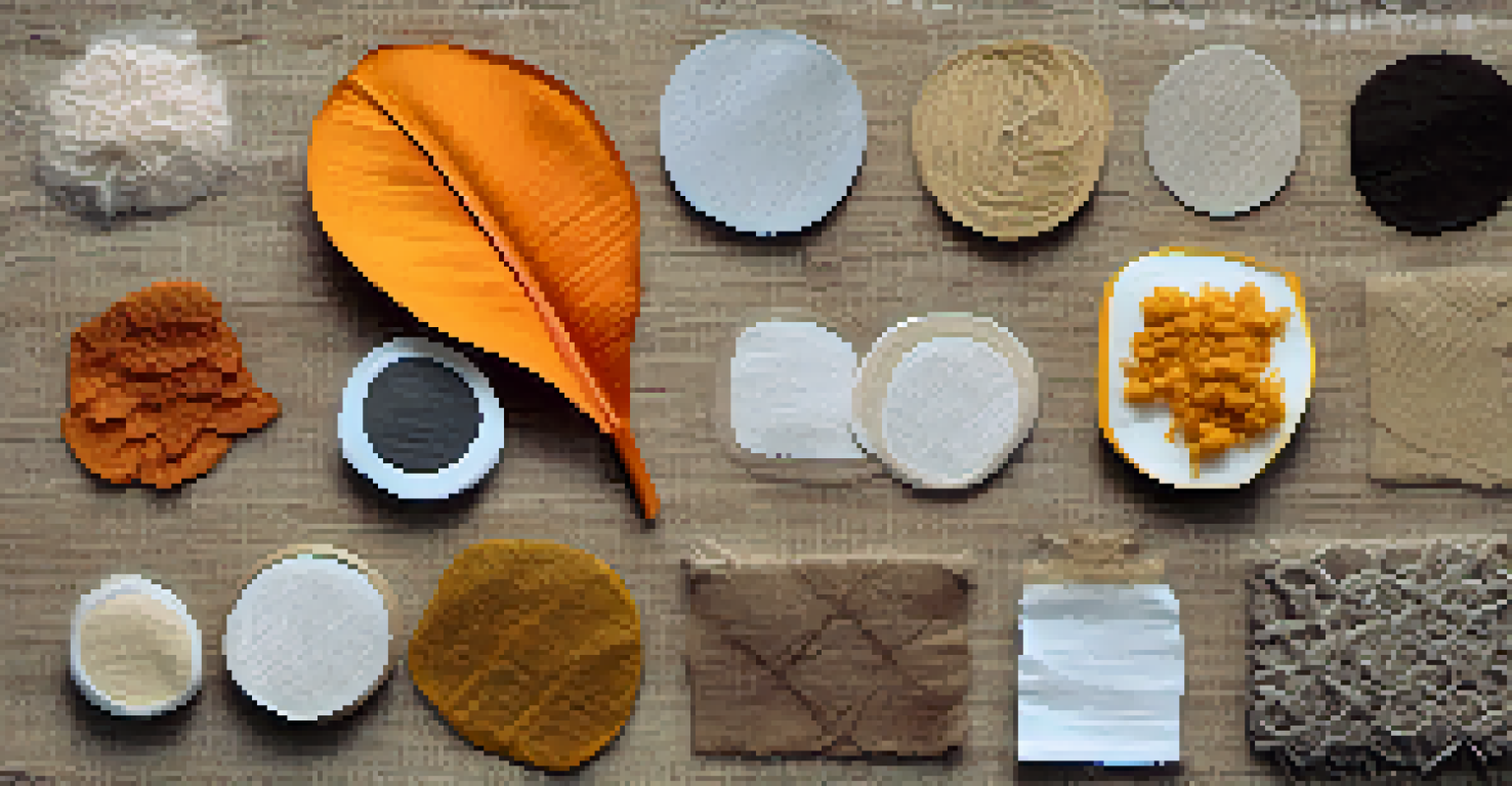Biodegradable Textiles: The Next Step in Sustainable Fashion

Understanding Biodegradable Textiles and Their Importance
Biodegradable textiles are fabrics that can decompose naturally over time, reducing environmental impact. Unlike traditional fabrics that can linger in landfills for decades, these materials break down through natural processes. This shift is crucial as the fashion industry grapples with its waste problem and the urgent need for sustainable solutions.
The greatest threat to our planet is the belief that someone else will save it.
These textiles are often made from natural fibers like organic cotton, hemp, or innovative materials such as Tencel, derived from wood pulp. By choosing biodegradable options, consumers can contribute to a circular economy, where products are designed with their end-of-life in mind. This approach not only benefits the planet but also encourages brands to be more transparent about their sourcing and production methods.
Moreover, the rise of biodegradable textiles signals a broader cultural shift towards sustainability in fashion. As consumers become more eco-conscious, they demand products that align with their values, pushing brands to innovate. This awareness is fostering a new generation of designers and companies committed to creating stylish yet environmentally friendly clothing.
The Environmental Impact of Conventional Textiles
Conventional textiles, such as polyester and nylon, are notorious for their environmental toll. These synthetic fabrics are derived from petroleum, a non-renewable resource, and their production contributes significantly to greenhouse gas emissions. Additionally, they can take hundreds of years to decompose, leading to massive waste accumulation in landfills and oceans.

Moreover, the dyeing and finishing processes used in conventional textiles often involve toxic chemicals that can pollute water sources. This not only harms aquatic life but also affects communities that rely on these water bodies for their livelihoods. By contrast, biodegradable textiles offer a much cleaner alternative, minimizing pollution and reducing the overall carbon footprint of the fashion industry.
Biodegradable Fabrics Reduce Waste
Biodegradable textiles decompose naturally, significantly diminishing the environmental impact compared to traditional fabrics.
The fashion industry is one of the largest polluters globally, and addressing this issue is paramount. By opting for biodegradable materials, brands can significantly lessen their environmental impact and set an example for others to follow. The shift towards sustainable practices is not just good for the planet; it's also a smart business move as consumers increasingly prefer eco-friendly options.
Innovations in Biodegradable Textile Materials
Recent advancements in textile technology have led to the creation of innovative biodegradable materials. For instance, companies are exploring mycelium, the root structure of mushrooms, as a sustainable alternative to leather. This not only reduces the reliance on animal products but also creates a biodegradable option that can break down naturally.
Sustainability is no longer about doing less harm. It’s about doing more good.
Another exciting development is the use of plant-based fibers, such as banana, pineapple, and even orange peels, to create textiles. These materials not only provide unique textures and aesthetics but also help reduce agricultural waste. By transforming these by-products into fashionable fabrics, the industry can turn waste into a resource, promoting a circular economy.
These innovations are pushing the boundaries of what biodegradable textiles can be, offering consumers more choices than ever before. As designers experiment with these materials, we can expect to see a wave of creativity that marries sustainability with style. The future of fashion is not just about looking good; it’s about feeling good about the choices we make.
The Role of Brands in Promoting Biodegradable Textiles
Fashion brands play a crucial role in the adoption and promotion of biodegradable textiles. By prioritizing sustainable materials in their collections, they can lead the charge towards a greener industry. Brands like Stella McCartney and Patagonia are already setting an example, proving that eco-friendly fashion can be both trendy and profitable.
Moreover, transparency in sourcing and production methods can build trust with consumers. When brands are open about their practices and the materials they use, it encourages shoppers to make informed choices. This not only bolsters brand loyalty but also inspires other companies to follow suit, creating a ripple effect throughout the industry.
Brands Drive Sustainable Choices
Fashion brands that prioritize biodegradable materials not only set industry standards but also foster consumer trust and loyalty.
As more brands embrace biodegradable textiles, the demand for these materials will likely increase, further driving innovation. This shift not only benefits the environment but also aligns with a growing consumer base that prioritizes sustainability. The fashion industry must recognize its influence and responsibility in shaping a more sustainable future.
Consumer Awareness: The Key to Sustainable Fashion
Consumer awareness is a powerful driver of change in the fashion industry. As shoppers become more informed about the environmental impact of their purchases, they are increasingly opting for sustainable options. This growing demand for biodegradable textiles is pushing brands to rethink their strategies and offerings.
Social media plays a pivotal role in raising awareness about sustainable fashion. Influencers and activists are using these platforms to educate their followers on the benefits of biodegradable materials. This increased visibility is encouraging consumers to take a closer look at their wardrobe choices and consider the environmental implications of fast fashion.
By supporting brands that prioritize sustainability, consumers can make a significant impact. Every purchase is a vote for the kind of fashion industry they want to see. As more individuals embrace eco-friendly practices, the collective effort can drive the transition towards a more sustainable future in fashion.
Challenges Facing Biodegradable Textiles
Despite the promise of biodegradable textiles, several challenges remain. One of the primary concerns is the scalability of production. While innovative materials are emerging, they often require specialized processes that can be costly and time-consuming. This can make it difficult for smaller brands to adopt these sustainable practices without significant investment.
Another challenge is consumer education. Many shoppers still associate biodegradable materials with lower quality or durability. Overcoming this perception requires effective marketing and clear communication about the benefits of these textiles. Brands need to showcase how biodegradable fabrics can compete with traditional options in terms of style and longevity.
Consumer Awareness Fuels Change
Informed consumers are increasingly opting for sustainable fashion options, driving demand for biodegradable textiles and influencing brand practices.
Lastly, the infrastructure for recycling and composting these materials is still developing in many regions. For biodegradable textiles to fulfill their potential, communities need access to proper disposal methods. Building this infrastructure will take time and collaboration between brands, consumers, and local governments.
The Future of Biodegradable Textiles in Fashion
The future of biodegradable textiles in fashion looks promising as innovation continues to flourish. With increasing awareness and consumer demand, more brands are likely to invest in sustainable materials. This shift could redefine the industry, making eco-friendly fashion a mainstream choice rather than a niche market.
As technology advances, we can expect to see even more creative uses of biodegradable materials. From smart textiles that adapt to environmental conditions to multifunctional fabrics that serve multiple purposes, the possibilities are endless. These innovations will not only enhance the appeal of biodegradable textiles but also contribute to a more sustainable lifestyle.

Ultimately, the integration of biodegradable textiles into mainstream fashion represents a significant step toward a more sustainable future. By embracing these materials, the industry can reduce its environmental footprint and promote ethical practices. Together, brands and consumers can pave the way for a fashion revolution that values style and sustainability equally.